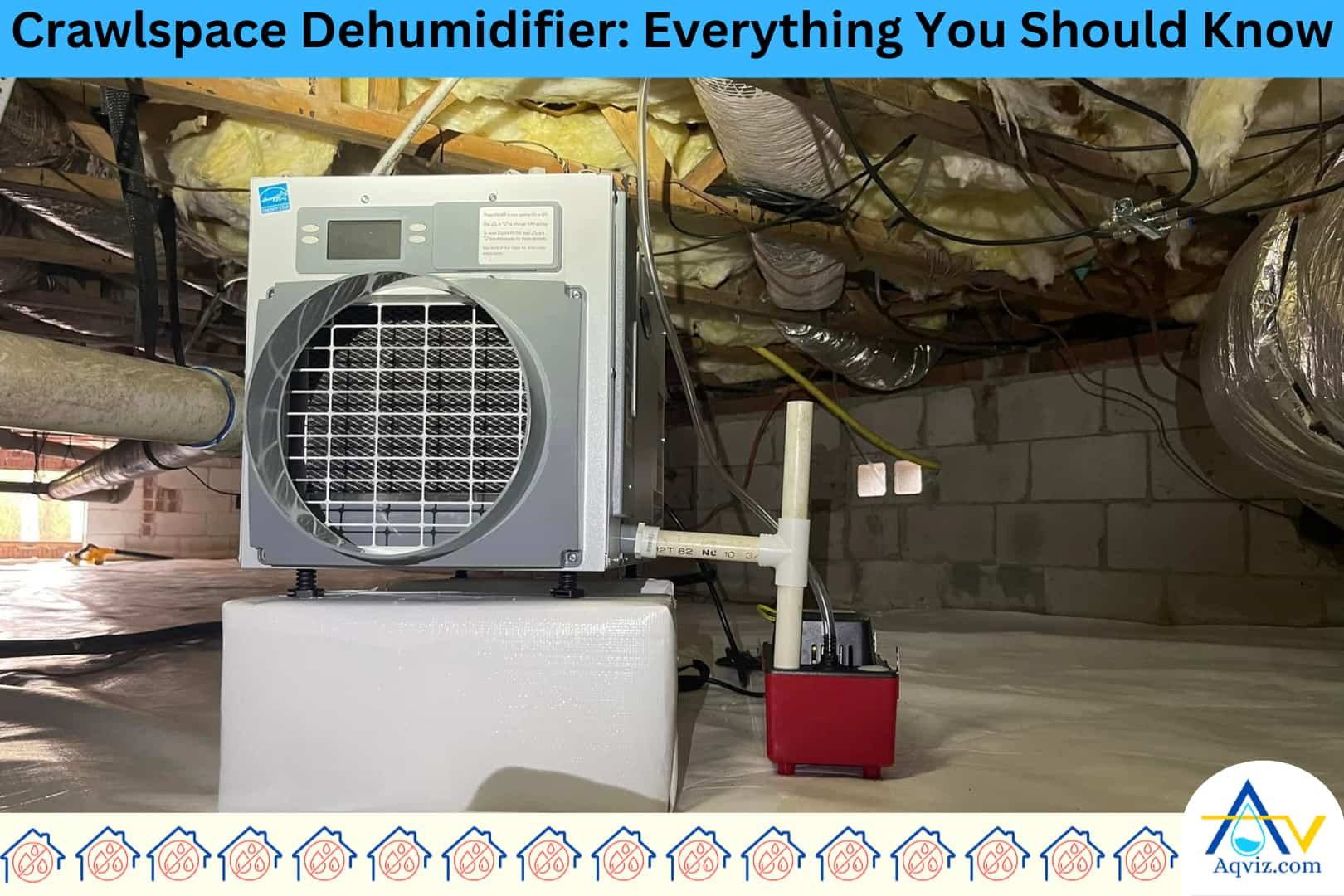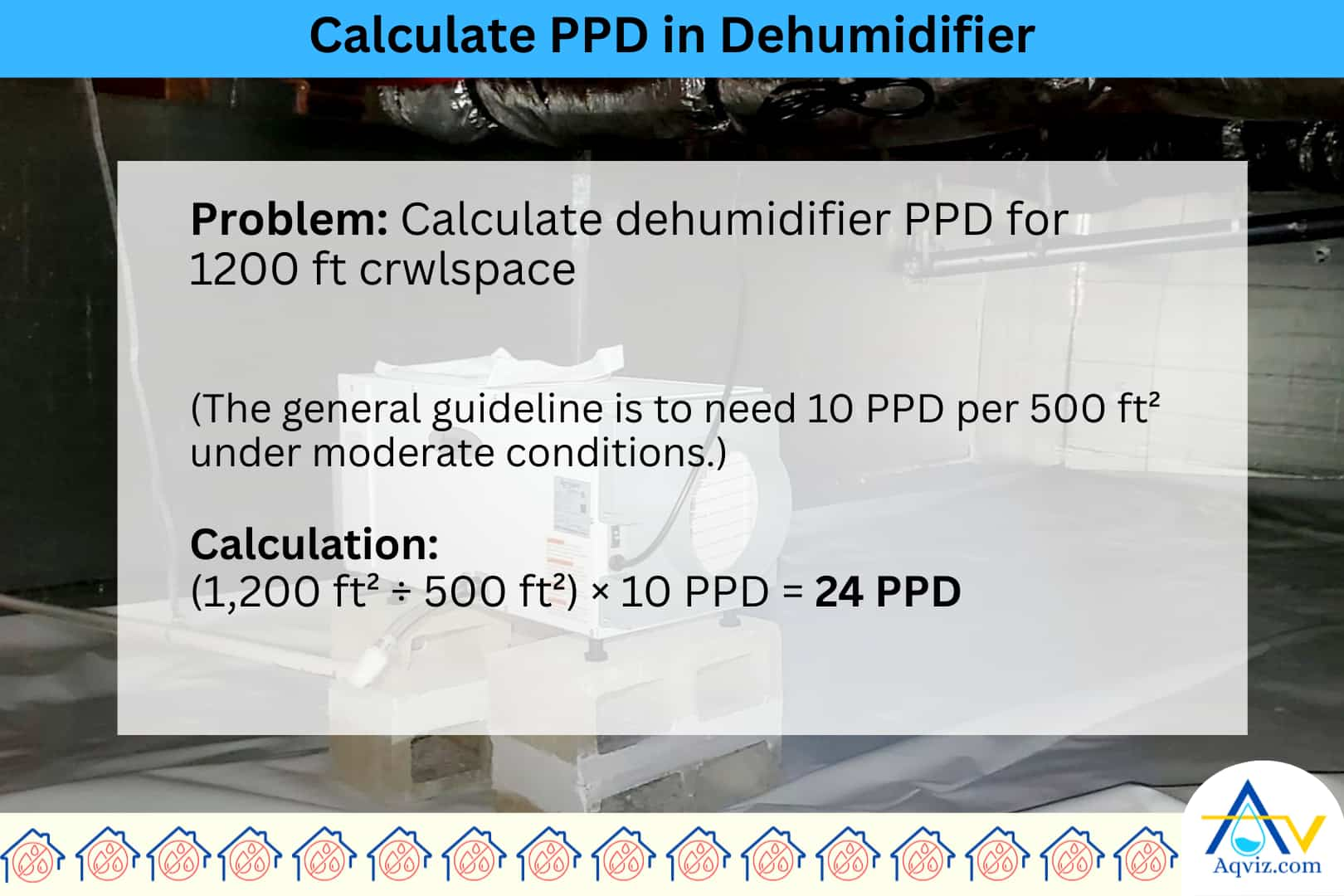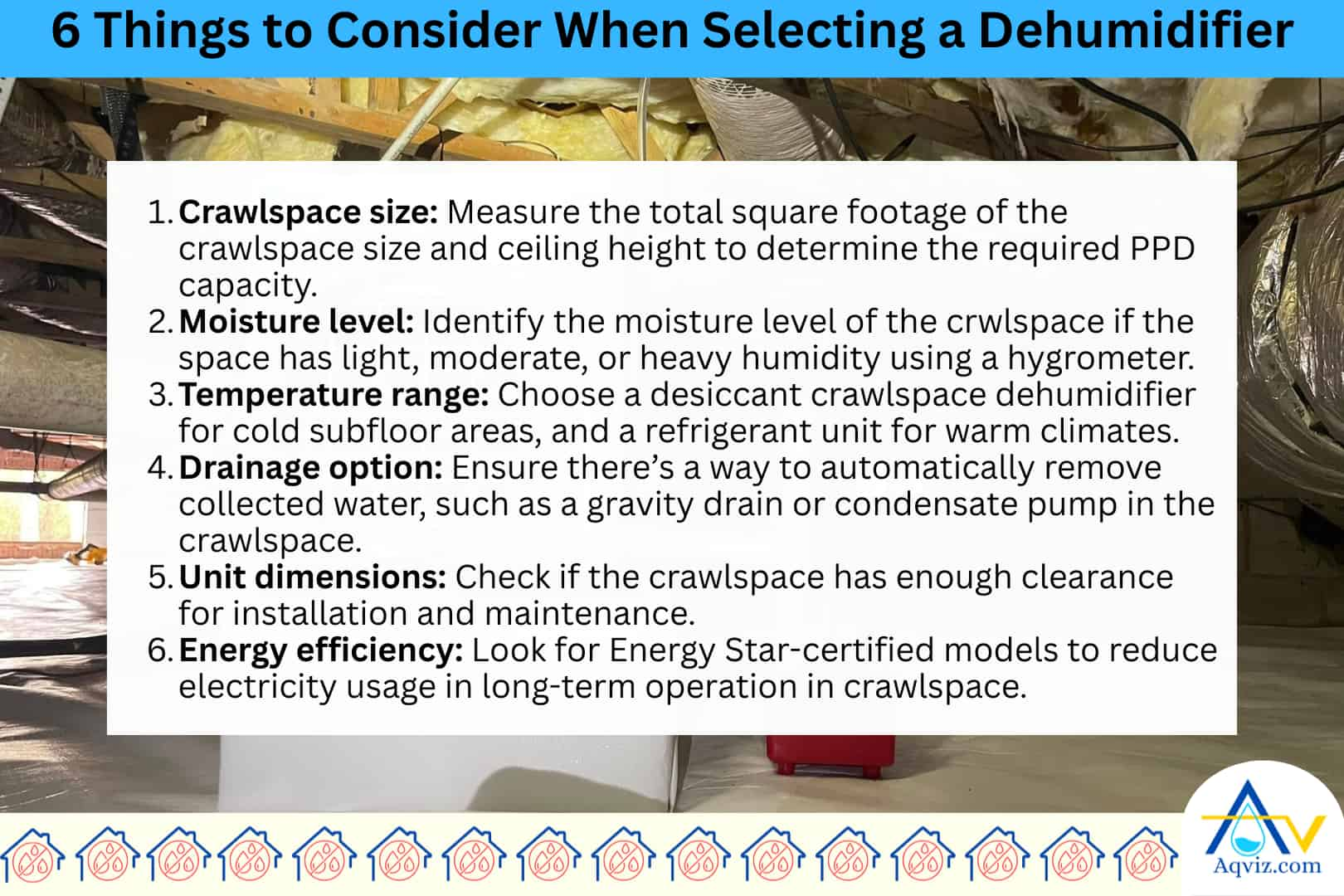Crawlspace Dehumidifier: Everything You Should Know

A crawlspace dehumidifier is a mechanical unit designed to remove excess moisture from the air in the void space below the building. The main purpose of installing crawlspace dehumidifier is to control the humidity level within the subfloor area to prevent moisture-related damage.
PPD (Pints Per Day) is the measurement of removing moisture using the dehumidifier. You can calculate the PPD of a crawlspace dehumidifier by using the crawlspace floor area. Normally, 10 PPD is needed for the 500 sqft of crawlspace floor. A dehumidifier should run in the crawlspace until it maintains relative humidity between 45% and 55%.
There are three main types of crawlspace dehumidifiers: refrigerant-based, desiccant, and thermo-electric. When you select a dehumidifier for the crawlspace, Aqviz highly recommends that you to consider the crawlspace size, moisture level, temperature range, drainage option, unit dimension, and energy efficiency of the dehumidifier. You should always follow the IRC code when dealing with crawlspace with moisture.
Aqviz experts highly recommend to place the dehumidifier in the center of the crawlspace or near the most humid section to ensure even air distribution and maximum moisture extraction. You should follow the below-mentioned 6 step by step guide to install a crawlspace dehumidifier.
In order to improve the crawlspace dehumidifier efficiency, you should seal vents, install a vapor barrier, insulate crawlspace walls, maintain drainage, and clean the dehumidifier air filters regularly. Else it may cause to reduce the effectiveness and cause system failures in the crawlspace dehumidifier.
What is a Crawlspace Dehumidifier?
A crawlspace dehumidifier is a mechanical unit designed to remove excess moisture from the air in the void space below the building. Crawlspace dehumidifier operates in tight, enclosed areas such as underfloor spaces, pier and beam spaces, and subfloor areas, where moisture buildup is common due to poor ventilation and ground vapor. Crawlspace dehumidifier draws in humid air, extracts water vapor, and circulates dry air to maintain a stable humidity level that protects the structural components of the building.
There are five main advantages of using a crawlspace dehumidifier:
- Prevents mold growth by maintaining humidity below 60% in the crawlspace
- Controls musty odors caused by damp conditions in the crawlspace
- Protects wood framing from rot and deterioration in the crawlspace
- Improves energy efficiency by supporting HVAC performance in the crawlspace
- Reduces pest activity by eliminating damp environments in the crawlspace
Read More About: Crawlspace Waterproofing: Everything You Should Know

What is the Purpose of a Dehumidifier in the Crawlspace?
The main purpose of a crawlspace dehumidifier is to control the crawlspace humidity level within the subfloor area to prevent moisture-related damage. Crawlspace dehumidifier plays a critical role in maintaining a dry environment in enclosed foundation spaces, especially where natural airflow is limited. Without proper moisture control, the crawlspace becomes a breeding ground for mold, wood rot, and poor indoor air quality that can rise into the living space through the stack effect.
What is PPD in a Dehumidifier?
PPD stands for Pints Per Day, which measures the amount of moisture a crawlspace dehumidifier can remove from the air in a 24-hour period. PPD is a critical performance rating used to determine the drying capacity of a dehumidifier under specific conditions. Most crawlspace dehumidifiers are rated using two standards: AHAM (American Home Appliance Manufacturers) conditions, which represent average real-world usage, and saturation conditions, which reflect maximum capacity in extreme humidity.
PPD is important because it helps match the crawlspace dehumidifier capacity to the moisture load in the foundation void. An undersized crawlspace dehumidifier may run continuously without achieving ideal humidity, leading to energy waste and poor results. On the other hand, an oversized dehumidifier may short-cycle, causing premature wear. Selecting the right PPD rating ensures efficient drying, stable humidity control, and longer equipment life in any crawlspace below the building.
How to Calculate the Size of a Dehumidifier for the Crawlspace?
To calculate the correct size of a crawlspace dehumidifier, measure the square footage of the subfloor area and evaluate the moisture condition. The crawlspace dehumidifier size is typically based on both the crawlspace area (in square feet) and the humidity level (light, moderate, or heavy dampness). The output capacity should be measured in PPD (Pints Per Day) to match the crawlspace moisture removal needs efficiently.
Here’s a simple example to calculate the dehumidifier in the crawlspace.
If the crawlspace measures 1,200 ft² with moderate moisture, the general guideline is to need 10 PPD per 500 ft² under moderate conditions.
Calculation:
(1,200 ft² ÷ 500 ft²) × 10 PPD = 24 PPD
In this case, a crawlspace dehumidifier rated at 24–30 PPD under AHAM conditions would be appropriate. aqviz experts always recommend you to round up to ensure consistent performance, and increase capacity by 10-15% for heavy moisture or high water table zones in the pier and beam space.

How long should a Dehumidifier Run in the Crawlspace?
A crawlspace dehumidifier should run continuously or in cycles based on the humidity level, with the goal of maintaining relative humidity between 45% and 55%. In most subfloor areas, the dehumidifier runs for 8 to 12 hours per day, depending on insulation, vapor barrier condition, and outside climate. Crawlspace dehumidifier units with built-in hygrostats automatically adjust their runtime to maintain the target humidity without manual control.
Crawlspace dehumidifier typically operates most during spring, summer, and early fall, when outdoor humidity is high and ground moisture increases. In humid regions like the Southeastern U.S., a crawlspace dehumidifier may run year-round, while in cooler, drier climates, runtime may drop in winter months. You should always monitor humidity with a digital gauge to verify the crawlspace dehumidifier is running efficiently through seasonal changes.
What are the types of Dehumidifiers for Crawlspaces?
There are three main types of crawlspace dehumidifiers: refrigerant-based, desiccant, and thermo-electric. Each crawlspace dehumidifier type has specific performance strengths depending on the subfloor area’s size, temperature, and moisture load.
- Refrigerant dehumidifier: Refrigerant dehumidifiers are best for moderate to high humidity in standard underfloor spaces above 60°F. Common in residential pier and beam spaces.
- Desiccant dehumidifier: Desiccant dehumidifiers are for low temperatures below 50°F or cold basement voids, often found in northern climates. Uses a moisture-absorbing chemical instead of refrigeration.
- Thermo-electric dehumidifier: Thermo-electric dehumidifier are suitable for small crawlspaces under 500 ft² with light moisture. Operates quietly with low power but has limited capacity.
Aqviz experts’ recommendation:
Crawlspace dehumidifier selection should match the crawlspace environment. For example, a refrigerant unit is reliable for damp southern zones, while a desiccant model performs better in cool cellar conditions or vented access spaces.
What should be Considered when Selecting a Dehumidifier for the Crawlspace?
Selecting the right crawlspace dehumidifier requires evaluating specific environmental and structural factors within the void space below the building. Here are six critical considerations before purchasing a crawlspace dehumidifier:
- Crawlspace size: Measure the total square footage of the crawlspace size and ceiling height to determine the required PPD capacity.
- Moisture level: Identify the moisture level of the crawlspace if the space has light, moderate, or heavy humidity using a hygrometer.
- Temperature range: Choose a desiccant crawlspace dehumidifier for cold subfloor areas, and a refrigerant unit for warm climates.
- Drainage option: Ensure there’s a way to automatically remove collected water, such as a gravity drain or condensate pump in the crawlspace.
- Unit dimensions: Check if the crawlspace has enough clearance for installation and maintenance.
- Energy efficiency: Look for Energy Star-certified models to reduce electricity usage in long-term operation in crawlspace.

What are the Recommended Codes for Crawlspace Dehumidifiers?
Recommended codes for crawlspace dehumidifiers are primarily guided by the International Residential Code (IRC) and ASHRAE standards to ensure proper moisture control in subfloor areas. According to IRC Section R408.3, when a crawlspace is sealed or encapsulated, mechanical dehumidification or conditioned air supply is required to maintain acceptable humidity levels.
Where should a Crawlspace Dehumidifier be Placed?
A crawlspace dehumidifier should be placed in the center of the crawlspace or near the most humid section to ensure even air distribution and maximum moisture extraction. Ideal placement is on a level, elevated platform, such as concrete blocks or a plastic stand, to prevent contact with ground moisture and improve airflow around the unit.
Place the crawlspace dehumidifier so that the air intake is unobstructed and the dry air discharge flows freely through the subfloor area. Avoid placing crawlspace dehumidifre in tight corners or behind structural piers that block circulation in the crawlspace. If the crawlspace has a multiple sections, position the crawlspace dehumidifier near the main duct path or install flexible ducts to cover larger zones.
How to Install a Dehumidifier in the Crawlspace?
Installing a crawlspace dehumidifier requires careful setup to ensure effective operation, proper drainage, and safe access. Below are the essential steps to install a crawlspace dehumidifier in a foundation void, subfloor area, or crawlspace:
- Inspect the crawlspace: Check for standing water, leaks, or open vents in the crawlspace. Then seal and dry the crawlspace before installation.
- Place a vapor barrier: Install a 6-mil or thicker polyethylene sheet over the ground surface to reduce ground moisture in the crawlspace.
- Set a stable platform: Use concrete blocks or a plastic stand to elevate the crawlspace dehumidifier above the vapor barrier.
- Position the unit: Place the crawlspace dehumidifier near the center or highest humidity zone with clearance around intake and discharge vents.
- Connect drainage: Attach a drainage hose to the unit and route it to a sump pump, gravity drain, or external outlet per code.
- Install a hygrometer: Position a humidity sensor in the crawlspace to monitor performance and adjust settings as needed.
- Plug into a GFCI outlet: Ensure the crawlspace dehumidifier connects to a grounded, code-compliant electrical outlet.
- Test the unit: Power on the crawlspace dehumidifier, set humidity to 50%, and confirm airflow and drainage are functioning properly.
How to Improve Crawlspace Dehumidifier Efficiency?
Maximizing crawlspace dehumidifier efficiency ensures lower energy use, faster moisture removal, and longer system life. Here are five proven ways to improve crawlspace dehumidifier performance.
- Seal vents and air leaks in the crawlspace
- Install a vapor barrier before installing a crawlspace dehumidifier
- Insulate crawlspace walls before installing a crawlspace dehumidifier
- Maintain proper drainage in the crawlspace
- Clean dehumidifier air filters regularly

What are the Common Problems with Dehumidifiers in the Crawlspace?
These are the common 6 problems that occur in the crawlspace dehumidifier, that cause to reduce effectiveness and cause system failures.
- A crawlspace dehumidifier with low PPD cannot handle high moisture loads, causing it to run constantly without reaching the target humidity.
- Obstructions near the crawlspace dehumidifier intake or discharge reduce efficiency and strain internal components.
- Dust and debris buildup restrict air circulation, lowering performance and increasing energy use.
- Improper drainage setup causes water to pool under the unit, risking overflow or electrical hazards.
- Oversized crawlspace dehumidifiers shut off too quickly, leading to inconsistent humidity and faster wear.
- In cooler cellar spaces, refrigerant-based units may freeze, especially without proper airflow or temperature control.
Read More About: Crawlspace Inspection: How to Do, Tools Checklist, Evaluation
Does a Waterproofed Crawlspace need a Dehumidifier?
Yes, a waterproofed crawlspace still needs a crawlspace dehumidifier to control airborne moisture. While waterproofing systems like vapor barriers, sump pumps, and foundation coatings effectively block liquid water entry, they do not remove humidity already present in the air or rising from the soil. Even in fully sealed subfloor areas, high relative humidity can accumulate due to seasonal changes, HVAC duct condensation, or internal air migration.
Crawlspace Fan vs. Dehumidifier: Which is Better?
A crawlspace dehumidifier is better for most modern homes, especially sealed or encapsulated crawlspaces. Crawlspace fans may help in dry climates with low ambient humidity, but in humid regions or during wet seasons, fans often draw in more moisture than they remove. Crawlspace dehumidifiers maintain stable indoor humidity levels between 45%–55%, prevent mold, and protect structural materials year-round.
Can a Crawlspace with a Dehumidifier Still Get Flooded?
Yes, a crawlspace with a dehumidifier can still get flooded due to heavy rain or poor grading, clogged or damaged gutters and downspouts, broken plumbing lines, sump pump failures, and higher hydrostatic pressure.
You should know this: A crawlspace dehumidifier is designed to remove moisture from the air, not to handle bulk water or surface flooding. Crawlspace flooding typically results from external water intrusion, which exceeds the capacity or purpose of a dehumidifier.
